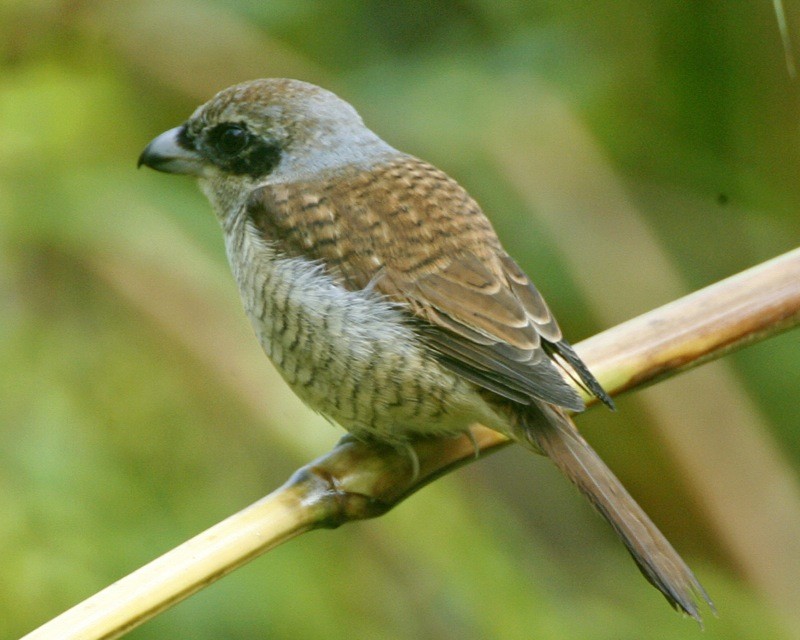Tiger Shrike
A species of Typical shrikes Scientific name : Lanius tigrinus Genus : Typical shrikes
Tiger Shrike, A species of Typical shrikes
Botanical name: Lanius tigrinus
Genus: Typical shrikes
Content
Description People often ask General Info
 Photo By Lip Kee Yap , used under CC-BY-SA-2.0 /Cropped and compressed from original
Photo By Lip Kee Yap , used under CC-BY-SA-2.0 /Cropped and compressed from original Description
It is a fairly small, stocky shrike, 17–19 cm long. Males weigh 27-29 grams and have a wing length of 77.8-83.9 mm, a tail length of 66.9-75.0 mm and a bill length of 14.1-15.9 mm. Females weigh 29-37 grams and have a wing length of 79.5-85.3 mm, a tail length of 66.3-79.1 mm and a bill length of 14.8-16.7 mm. The thick bill is blue-black with a black tip and the legs are grey-black. The adult male's back, rump and shoulders are reddish-brown with blackish bars creating a tiger-like pattern. It has a black forehead and mask and grey crown and nape. The wings and tail are brown and the underparts are white, sometimes with faint barring on the flanks. Females are duller and browner than the males with a less extensive black mask, less grey on the head, a narrow white stripe above the eye, pale patch between the bill and eye and buff-white flanks with black barring. Juvenile birds have dark scale-like markings on the head, back and underparts and lack the grey and black on the head. Their bill has a pale base and the eye appears large due to a pale ring around it. 
Size
19 cm
Colors
Brown
Black
Gray
White
Nest Placement
Shrub
Feeding Habits
Tiger Shrike's diet consists primarily of insects like grasshoppers and beetles, supplemented with arthropods, small birds, and lizards. It hunts from perches and explores foliage for prey, displaying less conspicuous perching behavior compared to other shrikes.
Habitat
Tiger Shrike finds its breeding grounds in temperate deciduous or mixed woodlands, often in forest fringes and agricultural areas with scattered trees, typically at lower elevations. In winter, it migrates to tropical and subtropical Southeast Asia, preferring forest clearings, edges, mangroves, and gardens, rarely above 1,000 meters. Its range extends from Eastern Asia in breeding season to Southeast Asia in non-breeding periods.
Dite type
Carnivorous
People often ask
General Info
Feeding Habits
Bird food type
Distribution Area
It breeds in temperate regions of eastern Asia in deciduous or mixed woodland, forest edges and farmland with scattered trees. It is found in lowland areas, mainly occurring below 150 metres in Russia, 800 metres in Japan and 900 metres in China. Its range covers Ussuriland in the Russian Far East north to about 44°N, central and eastern China, Korea and northern and central parts of the Japanese island of Honshū. It migrates southward in August and September, returning to the breeding grounds in May and June. It winters in tropical and subtropical regions of south-east Asia below 1,000 metres above sea-level. Its non-breeding range extends from south-east China south through eastern Burma, Thailand, Laos and Vietnam to Malaysia and Indonesia where a few reach Java and Bali in the south and Sulawesi in the east. In winter it occurs in forest clearings and edges, cultivated land, mangroves and gardens. Vagrant birds have occurred in Hong Kong and the Philippines. In Australia, a dead bird which may have arrived on a ship was once found near Fremantle and a bird was seen on Christmas Island in April 2008. It has a wide distribution and a fairly large population and is not considered threatened with BirdLife International classing it as least concern. However it has declined recently in Japan and Russia. In Japan, it is now uncommon and local but was formerly common and occurred in the suburbs of Tokyo. 
Species Status
Not globally threatened.
Scientific Classification
Phylum
Chordates Class
Birds Order
Perching birds Family
True shrikes Genus
Typical shrikes Species
Tiger Shrike